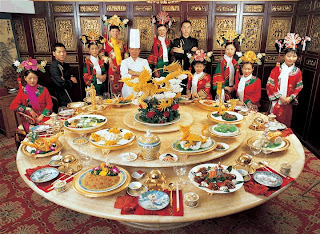Peking Duck is one of the most famous Chinese foods originating from the ancient royal courts. For centuries, the best Chinese chefs trained extensively in order to make sure that they could present this delicacy properly to the Emperor. In fact, their very lives depended on it. Today, no chef will lose his life for messing up his Peking Duck recipe but his self-esteem will be sorely dented. However, with attention to detail, a modern day Peking Duck can be a feast fit for royalty. Here's just one of the many up to date Peking Duck recipes:
Ingredients
1 3.5 - 4 lb duck (fresh or frozen)
2 pints water
3 tbsp dark soy sauce
3 tbsp honey
5 fl oz rice wine (you can use dry sherry)
1 lemon
2 pints water
3 tbsp dark soy sauce
3 tbsp honey
5 fl oz rice wine (you can use dry sherry)
1 lemon
To serve:
8 - 12 Chinese Pancakes
4 - 6 tbsp hoisin sauce
16 - 24 spring onions (cut into thin slivers lengthwise or into brushes)
4 - 6 tbsp hoisin sauce
16 - 24 spring onions (cut into thin slivers lengthwise or into brushes)
In China, ducks are specially raised on a diet of soybeans, maize, sorghum and barley for just six weeks, when they are ready for cooking.
Normally, the preparation of Peking Duck is rather time consuming and complex. The duck must be cleaned and plucked thoroughly, then air should be piped in to separate the skin from the flesh which let the skin roast to a lovely crispness. While the duck dries a sugar solution is brushed over the duck and it is then roasted in a wood fired oven. However, with our modern life styles being what they are, this Peking Duck recipe is rather less complicated.
Rinse and dry the duck thoroughly, blotting with kitchen paper.
Mix the water, dark soy sauce, honey and rice wine together and combine with the lemon cut into thick slices and bring to the boil then simmer for about 20 minutes. Ladle the mixture over the duck several times, ensuring that the skin is thoroughly coated. Hang the duck up to dry somewhere cool and well ventilated with a roasting tin beneath it to catch any drips. When the duck is properly dry the skin will feel like paper.
Roast the duck on a rack over a roasting tin in which you have water to a depth of about two inches (this stops the
fat splashing), in a pre-heated oven 475ºF, 240ºC, Gas 9 for 15 minutes. Turn the oven temperature down to 350ºF, 180ºC, Gas 4 and continue cooking for 1 hour, 10 minutes.
Let the duck rest for about fifteen minutes before serving. You can carve the meat and skin into pieces using a knife or cleaver or you can shred it with a spoon and fork.
Serve the duck with warmed Chinese pancakes, spring onions and hoisin sauce.
Each diner takes a pancake, spreads on a little hoisin sauce then tops that with some meat and crispy skin followed by a spring onion brush or some strips of spring onion. The pancake and contents are then rolled up into a tube and eaten either with one's fingers or with chopsticks.
Even this simple version of the classic Peking Duck makes a very special dinner party dish, fit for an Emperor.
Article Source: http://EzineArticles.com/3925499














